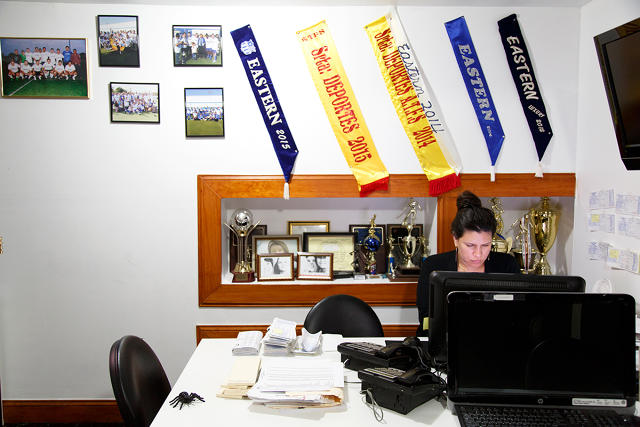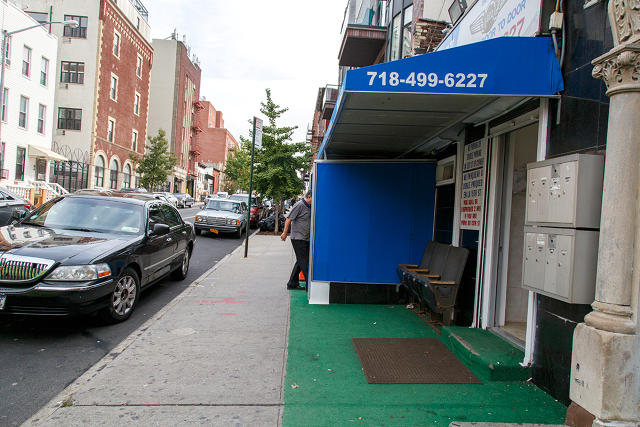In Brooklyn, mom-And-Pop automotive services and products Launch New Apps To Stave Off Uber
building an app that works is one factor—getting any individual to use it is some other.
October 21, 2015
it is late August, and for the past two weeks, Marvin Aleman has been fielding questions from the 275 livery automotive drivers who settle for jobs from his stepfather’s dispatching base, eastern automotive provider. Aleman is the final manager on the firm, which has been running in south Brooklyn for a quarter century. but he is also the senior programmer, an not likely job title at a neighborhood automotive carrier like jap, and he’s busy ironing out the kinks in a brand new app he helped develop for his fleet.
“Why did you press cancel?” he asks a driver in a green button-down shirt and khakis who has just shuffled into his basement workplace to reveal an issue with a transaction. “It’s now not a problem,” Marvin tells him. He can simply write up a receipt like he would in any other case. “however be careful subsequent time.”

Aleman’s stepfather, who he refers to as his father, started eastern about 25 years in the past. Aleman obtained into the domestic business about 10 years in the past, with the intention of creating a web page to keep the corporate related. Having studied graphic design in class and picked up some programming talents through other jobs, he constructed a device that allowed shoppers to e book rides on-line, including specifying a automotive seat or a distinct vehicle. web bookings have never accounted for far of eastern car carrier’s business—about five or 10%—however within five years, the business doubled from a hundred drivers to more than 200—and Aleman stayed on.
although he had lengthy suspected that apps were the next frontier for car services, he most effective started working on his a few 12 months ago. eastern automobile provider’s major advertising technique before that was simple—based totally on peppering the neighborhood with business cards—nevertheless it more or less worked. He couldn’t convince his parents to just accept the chance of growing something new for a machine that wasn’t broken. “They have been k with established order,” he says.
Then got here Uber.
It wasn’t so much that japanese was once shedding buyers as that it was once more difficult to maintain drivers. Uber campaigned hard to win over drivers by offering, for example, $500 cash bonuses after 20 rides. “Uber’s disruption is way more than just taking our drivers,” Aleman says. “Drivers occasionally abandon our buyers due to the truth that they may have gotten every other job from Uber on the comparable time.” consistent with one file, the carrier now offers virtually half of the paid rides in major markets.
Driver cooperation is essential as a result of automotive products and services have totally different trade models than Uber’s 25% to 30% commissions on fares. Drivers at japanese pay a flat rate initially of the week for access to a pipeline of jobs, which means that drivers are simply as much buyers of dispatchers as are riders. That partly explains the constant filtering of drivers thru japanese’s place of job. “they’ve a voice here,” Aleman says.

Taxis, for his or her part, have reacted to Uber by adopting apps of their own. Arro, a journey-hailing app for yellow taxis, launched in early September. Verifone’s Way2Ride app rolled out a trip-hailing feature for big apple and Philadelphia. Hailo made a failed attempt at getting New York city taxi drivers to download its hailing app. Washington, D.C., is making its personal metropolis-built, mandatory app. And cities like Chicago and l. a. have mandated taxis to use a common trip-sharing app.
In 2013, the number of community car base licenses issued by means of the NY city TLC was 498; in 2014, it was once 507. Uber has no longer yet been disastrous to the neighborhood automobile products and services, however it’s squeezed them enough in order that they really feel it. Small nearby automobile services and products like eastern are neither venture-capital-infused tech startups nor taxi conglomerates. As Uber rolls farther from city centers and into the boroughs, they have fewer resources with which to compete. however they are nonetheless putting up a security. One carrier launched an promotion campaign for its app that coyly poked enjoyable at Uber’s surge pricing and safety issues (“a lady will have to have the ability to be picked up without being picked up“). “they’re transferring with the applied sciences as a result of they see there is just one method to succeed,” says Pedro Gonzales, the founding father of a instrument company referred to as visible Dispatch that designs merchandise for nearby car products and services. “in the event that they don’t have what is required, they’ll disappear.”

though eastern would possibly be one of the most handiest regional automotive products and services that has developed its personal app, many others have signed on to white-label options supplied with the aid of companies like visible Dispatch. The small businesses, lots of whom have been operating in neighborhoods for many years, aren’t always wanting to adopt the new technology. “you have to understand,” Gonzales says. “now not all drivers like the theory. The youthful the motive force it is, the easier it’s to introduce this.”
Uber reviews that about 20% of Uber’s drivers are younger than 29, and 30% of them are younger than 39. the average age of a for-rent driver in New York city is forty seven. that can make introducing new technology tough. “plenty of our drivers are old-fashioned,” Aleman says. “Now they’re having a look on the display, so they kind of really feel like, ‘what’s going on?’ With the radio, it used to be extra noisy.”
Even after bringing on drivers, convincing clients to download an app for making reservations is a wholly different and even more daunting process.
Arecibo, a 26-12 months-previous neighborhood automobile provider simply blocks faraway from jap, lately launched an app the usage of visible Dispatch’s instrument. a couple of month after it launched, I asked a supervisor what number of clients had used it.
“About 10,” she informed me.
10%?
“No, we’ve got about 10 people who use the app.”

The basement place of job of the eastern automobile products and services is decorated with images of soccer teams. the corporate has a team annually, made up of drivers and dispatchers, and it performs in opposition to groups from different neighborhood automobile products and services.
The pleasant contention extends past soccer. car services and products—and their drivers—have an extended history of competing towards each and every other. When Aleman invited 10 drivers to pilot jap’s new app in August, about 30 confirmed up, having heard about the app throughout the grapevine. “They were excited to peer one thing new,” Aleman says. “They need to get their hands on it and notice if they can get an side over different drivers.”
one in all Uber’s most handy traits is that it may be used anyplace. buyers don’t need to obtain a separate app after they transfer from Queens to the Bronx. This, too, is what makes an idea like Arro work. since the app companions with a company referred to as creative cellular technologies, which gives cost techniques in New York city taxis, it is ready to present blanket coverage with about 8,500 of town’s taxis.
on-line reserving services and products like Flitways (formerly called OnCabs) have introduced this one-stop convenience to automotive services through working with drivers instantly. though they pay drivers via automobile services if they have a contract with those drivers, there’s no longer a lot combating them from slicing them out of the equation entirely in the future.
To an outsider, the apparent resolution is for car services and products to collaborate, and Gonzales is growing a characteristic that might help them work collectively. If a base opts in, customers who use its app to request a car in an area that its dispatch service doesn’t cover will be mentioned some other dispatcher in the area. but combining forces just isn’t that easy. “that would transform one base,” says Johanna Espinoza, a manager at Arecibo, after I ask her concerning the idea. “The owner needs to be impartial, they wish to have their own clients. They wouldn’t do that.”

about a month in, Aleman has onboarded all of his drivers to the platform. The app permits them to accept jobs nearest to them, which is extra environment friendly for everyone, and makes use of square integration to allow easy credit card payments. not like Uber, they are able to additionally still accept cash and tips. sooner or later, there will probably be a customer-dealing with part on the way to allow customers to hail cars as smartly.
There’s still a flow of drivers walking through Aleman’s place of business, but it’s thinning. Now he’s working with his associate building firm, Re#, on the client facet of the app, which he plans to launch on the end of October.
In his top world, he would make an app that labored with automobile services and products in different boroughs. When the buyer referred to as for pickup, they wouldn’t necessarily know the identify of the native automotive carrier that may fulfill their request. They’d just comprehend that they might open Aleman’s app and a automotive would come (the app would allow them to recognize from the place after it targeted a driver). That will not essentially fly on the earth of decades-long competition. “the bottom homeowners are paranoid, they usually’re worried about dropping drivers to next-door rivals,” Aleman says. however when he talks about how it will work for purchasers after they’re, say, in New Jersey or another part of Brooklyn, his stepfather is more keen to pay attention.
the game has changed, Aleman tells him: “the real competitor is Uber.”
quick company , learn Full Story
(81)














